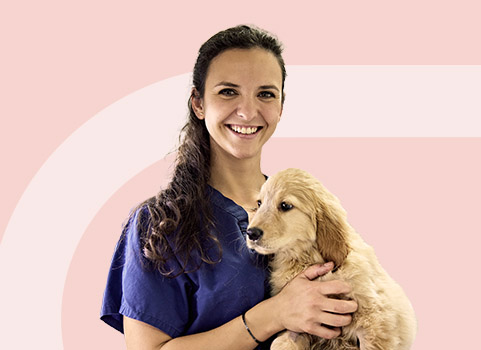
What to Know About the Vet Tech Externships
Oct 16, 2024
7 min read
One of the biggest parts of your vet tech education is the externships. While they’re required to graduate and take the next steps in your career, they also give you the opportunity to learn skills in the real world and network with other veterinary professionals! Externships can, however, seem intimidating and confusing! We spoke with members of our externship team to help you better understand what to expect and how to make the most of your hands-on experience!
What is the externship like?
“A veterinary technician externship is an invaluable part of a student’s education, offering practical, real-world experience that enhances classroom learning,” says Lindsay Bartkowski, Licensed Veterinary Technician (LVT) and Penn Foster Externship Assistant. “Externs develop technical skills, improve client communication, experience the fast-paced nature of veterinary work, and build professional networks—all while learning under the guidance of experienced professionals. It’s a challenging yet rewarding experience that prepares students for the demands of the veterinary field and gives them the confidence to begin their careers as competent, skilled veterinary technicians.”
Kelly Blood, Registered Veterinary Technologist (RVTg) and Penn Foster Clinical Coordinator and Evaluator, agrees on the value of the externships. “The externship is a time where students are able to explore all that they have learned during their course work in a hands-on environment. They work with veterinary staff learning from real life experiences and work one-on-one with approved mentors to ensure they are trained well to proficiently complete all AVMA-CVTEA required skills once the program is complete, and they are ready to be in the workplace.”
As part of your Veterinary Technician Associate Degree, you’ll have the opportunity to build your skills in two externships – one at the end of semester 2 and the other at the end of semester 4.
Read more: Vet Tech Unveiled: Expert Answers to Your Burning Questions
Why are the externships important to a vet tech’s education?
While the majority of your coursework is online, the externships give you the opportunity to apply what you learned to real-world situations – and also allow you to experience what it’s like to work in a veterinary clinic or hospital.
“The veterinary technician externships are a crucial component of a veterinary technician’s education for several reasons,” Lindsay told us. “They bridge the gap between textbook learning and real-world application, offering students the opportunity to gain hands-on experience in a clinical setting and practice their technical skills. It also provides exposure to different veterinary environments and specialties. We hope it helps build professional relationships for networking and mentorship opportunities outside the externship and once they have graduated.”
Besides being important for your education and a requirement for AVMA accredited programs, “externships are essential for vet tech students to be able to function and thrive in a veterinary clinic once graduated and certified,” Kelly mentions. “Learning the how's and why's from a text is incredibly important but does not prepare you to be able to handle different species and temperaments of patients, client situations, emotional and physical demands of the job, nor give you the practice to be a viable part of a team when needed.”
Read more: How to Pass the VTNE
What are the benefits of vet tech externships?
The externships come with many benefits outside of just fulfilling academic requirements for your vet tech degree.
“The skills learned during the externships prepares students to be ready to be technically skilled to join any veterinary team after graduation. In addition, being able to work in a working clinic environment prepares students for many aspects of being a veterinary technician in addition to being able to treat and care for animals, like client care and communication, team work, the critical importance and ability to closely follow doctor's orders to ensure the care being given to the animals is correct and timely, and so much more - more than any reading or video could provide,” mentions Kelly.
Lindsay agrees, saying that, “They play a critical role in bridging the gap between academic learning and the realities of the professional world, ultimately giving students a strong foundation for future career success.”
What should students know about doing the externships?
The externships can be one of the more intimidating components of completing your veterinary technician degree. As part of the externship, you’ll need to find an approved site near you to complete your hours. There are several steps to securing a site, getting it approved, and starting your actual hours.
“When it comes to securing an externship, students should approach the process with preparation, professionalism, and patience,” Lindsay advises. It can take time to find the right site and it can also be frustrating, but it’s all part of the process! As you’re tasked with finding a site near you, Lindsay says the best way to get started is to:
- Understand the purpose and expectations of an externship
- Research potential externship sites. Make use of our externship locator tool that shows sites that have been willing to assist in externships in the past!
- Prepare for interviews or conversations (and be professional). Some sites require or appreciate resumes or letters of intent/interest.
When you’re approaching sites for your externship, it’s also important to be mindful and considerate of the clinic and their workload.
“Stopping into facilities during lunchtime hours are usually less busy and may allow for a personal interaction with the manager/technician in charge of overseeing externships,” says Kelly. “When possible, in-person outreach tends to leave the best impression. If you are unable to stop in person, call the facility and ask to speak to the person in charge of overseeing externships. Your first outreach should not be an email whenever possible.”
Read more: How to Become Certified as a Vet Tech (State-by-State)
Advice on successfully submitting your externship paperwork
When you’re ready to get started with your externship, it’s important to submit all the required paperwork to make sure you can get started as soon as possible.
Kelly has this advice for students: “Once you are ready to submit your clinical approval paperwork, it is important to carefully review the clinical handbook to ensure all required documents are completed and submitted. All paperwork should be submitted in a single PDF or DOCX file labeled with the site/supervisor name. The required site images listed in the course handbook are also submitted in the Site Images for Approval folder. Site images must be submitted along with the clinical documentation to ensure the site and supervisor meet AVMA-CVTEA and college requirements to have students complete their externships in a modern and compliant facility. Once all submissions are accepted, the clinical coordinator will need to have a brief conversation with the supervisor. Making sure that the supervisor knows to expect this call will ensure the approval of the externship site proceeds in a timely manner.”
Lindsay also advises to make sure you read through all the guides available to you! “The information and reference guides are lengthy,” she says, “but they are there for a reason! Read through them thoroughly as to not miss a step and have any delays. Check your emails regularly once you submit paperwork so you do not miss any communication from a member of the externship team.”
What can students do to get the most out of the externship?
Your externships are a great opportunity to learn and grow as a vet tech!
“To get the most out of their externship experience, students should actively listen and engage, be proactive, and approach the opportunity with a mindset focused on learning, growth, and professional development,” Lindsay says.
Kelly advises students to really take advantage of the experience of those they’re working with.
“Making the most of an externship experience is easy - take advantage of the experienced veterinarians and technicians that you are working with! Pay attention to how they complete skills and communicate with other staff as well as clients. Ask a lot of questions! Practice, practice, practice! The more hands-on experience that you can get, the more confident you will be to complete the task in any situation!”
Read more: Fear Free Certification for PF Vet Tech Students
We’re here to support you
It can be easy to get overwhelmed by all the schoolwork and clinical requirements that go into becoming a credentialed vet tech. It’s important to remember, though, what you’re working toward! And, when you get stuck, your instructors and externship team are here to help. Just go to the Help Center in your Learner Center and click Contact Support! Be as specific as you can with what you need help with so the right person can get you the help you need.
Learn more about one student’s veterinary technician journey: Vet Assistant to Vet Tech: Advancing Your Career as a Working Parent




